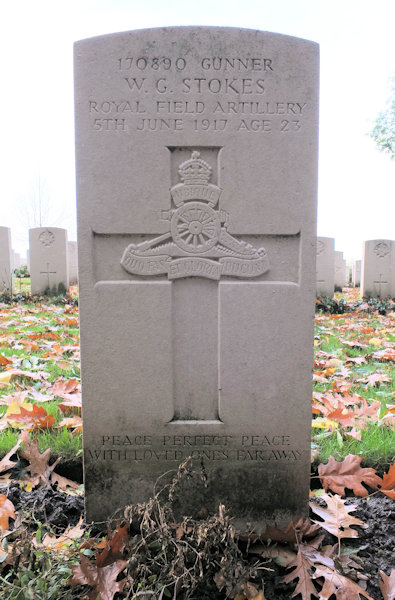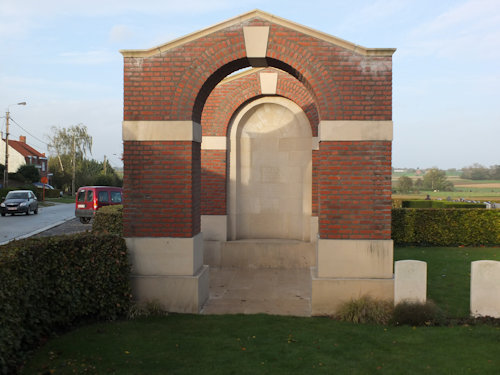Name
Walter George Stokes
29 Aug 1893
Conflict
First World War
Date of Death / Age
05/06/1917
23
Rank, Service Number & Service Details
Gunner
170890
Royal Field Artillery
'D' Battery, 180th Brigade
Awards: Service Medals/Honour Awards
British War and Victory medals
Cemetery/Memorial: Name/Reference/Country
KEMMEL CHATEAU MILITARY CEMETERY
D. 75.
Belgium
Headstone Inscription
Peace perfect peace with loved one's far away
UK & Other Memorials
Hitchin Town Memorial, St Mary's Church Roll of Honour (Book), Hitchin, British Schools Museum Memorial, Hitchin, Not on the Great Offley Village Memorial
Pre War
Walter was born on 29 August 1893 in (Great) Offley and christened there on 24 September 1893. His parents were George and Mary Eliza Stokes.
In 1901 the family were living at Offley Village near Hitchin. Present were both parents: George (48) and Mary (44), with George and working as a gardener. Their children were: Arthur William (17), Dorothy (15), Marguerite Emily (12), Mark Harly (10), Kathleen Elizabeth (9), Walter George (7) and Norman Edwin (4).
By 1911 the family had moved to Hitchin and were living at 18 Lancaster Road, Hitchin. Present were both parents, George recorded as a gardener domestic and Mary a dressmaker working from home. The census recorded they had been married for 30 years with 10 children, of whom 2 had died. Of the children listed above all were present except Dorothy, but an older sibling Herbert Morris (29) was now present. Walter was 17 and also working as a domestic gardener.
He was described as having a bright sunny character, intelligent and good-humoured and was well-known to the Hitchin Playhouse and as a member of the Hitchin Church Adult Class.
Officially he was recorded as born in Offley and he enlisted in Hitchin.
Wartime Service
Walter joined the Royal Field Artillery in October 1915 serving with ‘D’ Battery of the 180th Brigade. His Service Number was 170890 and he went to France in September 1916. He was killed in action in Flanders two days before the opening of the Battle of Messines.
‘D’ Battery was part of the 16th (Irish) Division in IX Corps of the 2nd Army. IX Corps were in the centre of the attack and the 16th Division were attacking the village of Wytschaete immediately east of where he was buried. The 180th Brigade was firing mainly gas shells from 4.5" howitzers. 2266 artillery pieces were involved in the Battle of Messines plus 19 landmines that were detonated under the German lines.
The artillery duel lasted for 8 days from the 31st May 1917 with intense bombardments and 3 million shells fired by the British. It resulted in a spectacular British victory planned by General (Daddy) Plumer, one of the British Generals who had any concern for the lives of his troops.
He was buried in Row D, Grave 75 in the Kummel Chateau Military Cemetery in Belgium.
Additional Information
Acknowledgments
Adrian Dunne, Adrian Pitts, David C Baines, Jonty Wild



